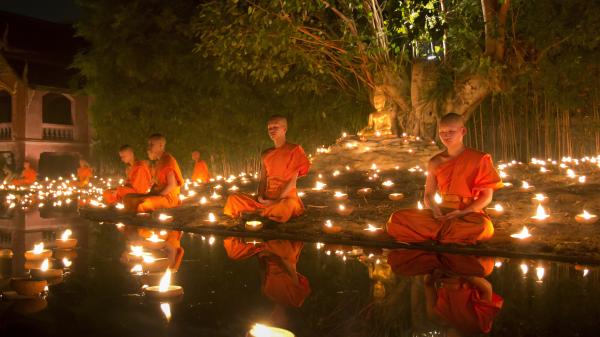The Buddhist Calendar
Buddhists around the world use a lunisolar calendar system to determine the dates of religious holidays.

Thai Buddhist monks on Magha Puja Day.
©iStockphoto.com/Toa55
Lunisolar Time Reckoning
The Buddhist calendar employs a lunisolar system, meaning that it keeps track of the apparent movements of both the Moon and the Sun. It is derived from the lunisolar Hindu calendar.
Developed in ancient Burma (present-day Myanmar) and traditionally used in many regions of Southeast Asia, it no longer has the status of an official calendar in any country.
Buddhist festivals whose date is calculated using this calendar include Magha Puja and Asalha Puja.
Holidays and festivals in Thailand
Holidays and festivals in Cambodia
Calendar Structure
The Buddhist calendar divides a common year into 12 months, their length alternating between 29 and 30 days. While this basic structure is common to all variants of the Buddhist calendar, the names of the months are different in each language. In some versions, numbers are used instead of names.
Months in the Buddhist Calendar
| Months (Sanskrit / Burmese) | Number of Days |
|---|---|
| Chaitra / Tagu | 29 |
| Vaisākha / Kason | 30 |
| Jyaiṣṭha / Nayon | 29 or 30 |
| Āṣāḍha / Waso (repeated in leap year) | 30 |
| Śrāvaṇa / Wagaung | 29 |
| Bhādrapada / Tawthalin | 30 |
| Āśvina / Thadingyut | 29 |
| Kārttika / Tazaungmon | 30 |
| Mārgaśirṣa / Nadaw | 29 |
| Pauṣa / Pyatho | 30 |
| Māgha / Tabodwe | 29 |
| Phālguna / Tabaung | 30 |
Months in the Gregorian calendar
Like in the Hindu calendar, each month is divided into two fortnights. The first fortnight has 15 days and comprises the waxing half of the phases of the Moon; the second fortnight has 14 or 15 days and covers the waning Moon phases.
When Does the Year Begin?
Another similarity between the Hindu calendar and the Buddhist system is the fact that the new year begins as the Sun traverses into the zodiac sign of Aries.
This date, as well as the Buddhist calendar year as a whole, is dependent on the length of a sidereal year, which is the time the Earth needs to complete a full orbit around the Sun in relation to fixed stars. Since this time span is about 20 minutes longer than a tropical year, which determines the onset of the seasons and which the western Gregorian calendar aims to reflect, the Buddhist year begins slightly later each year. At present, the Buddhist New Year falls into the second half of April, although there are regional variations.
When Was Year 1?
The Buddhist calendar uses the Gautama Buddha's date of death—or, in Buddhist terms, the moment Buddha reached parinirvana—as its starting point. While there is disagreement about the exact year, some versions of the calendar starting their year count in years 543 or 545 BCE, the most commonly observed year numbering system starts in year 544 BCE.
Leap Year Rules
The calendar designates 7 years within a 19-year cycle as leap years, in which an extra 30-day month is added following the summer month of Āṣāḍha / Waso. For further fine-tuning, 11 years within a 57-year cycle are defined as great leap years, where one day is added to the month of Jyaiṣṭha / Nayon. There are regional variations.
More about leap years in the Buddhist calendar
Leap years in the Gregorian calendar
Accuracy
Buddhist time reckoning is fairly inaccurate when it comes to reflecting the length of a solar year and the onset of the seasons. This is because it aims to reflect the length of a sidereal year while the 19-year cycle used to determine the distribution of leap years is based on the length of a tropical year.